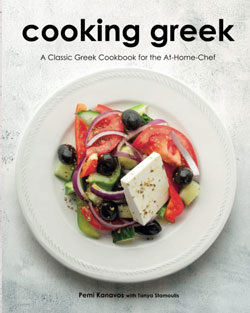Menu
Install the app
How to install the app on iOS
Follow along with the video below to see how to install our site as a web app on your home screen.
Note: This feature may not be available in some browsers.
You are using an out of date browser. It may not display this or other websites correctly.
You should upgrade or use an alternative browser.
You should upgrade or use an alternative browser.
Greek Food, Cooking and Recipe Community
What to add to your melitzanosalata to spice it up
- Thread starter efhernandez_
- Start date
1 - 2 of 2 Posts
k_tsoukalas
Administrator
Melitzanasalata is one of those delicious Greek dishes that I don't make much, but when I do have it, it's delicious.
1 - 2 of 2 Posts
JOIN THE DISCUSSION AND READ OTHER GREEK INFO:
Mediterranean Diet Tied to Lower Blood Pressure, Greek Study Shows!
- Hash
- Greek Food Forum
- Replies: 0
I drink a large tablespoon of pure Virgin Olive oil (0.3% acidity) whenever I remember!
https://greekreporter.com/2024/04/1...+to+Lower+Blood+Pressure_2C+Greek+Study+Shows
https://greekreporter.com/2024/04/1...+to+Lower+Blood+Pressure_2C+Greek+Study+Shows
Greek grilling advice and tips?
- paharo45
- Greek Food Forum
- Replies: 0
It's getting warm out and time to break out the grill! I am interested in how do Greek people in Greece grill? I've had so many delicious grilled foods in Greece, I am having a hard time getting the same flavors here in the United States.
I've tried my hand at a few recipes, aiming to capture that authentic taste, but I feel like there's a deeper level of technique and tradition that I'm just not hitting. From choosing the right ingredients to mastering the grill itself, I know there’s a wealth of subtleties that can turn a good dish into a great one.
Do they use certain marinades or techniques? I've watched people in Greece grill - they don't even really follow recipes.
I've tried my hand at a few recipes, aiming to capture that authentic taste, but I feel like there's a deeper level of technique and tradition that I'm just not hitting. From choosing the right ingredients to mastering the grill itself, I know there’s a wealth of subtleties that can turn a good dish into a great one.
Do they use certain marinades or techniques? I've watched people in Greece grill - they don't even really follow recipes.
Traditional Greek soups in Greece?
- blopez34
- Greek Food Forum
- Replies: 0
Most of the Greeks I know are from the United States - so it's been a few generations since a lot of them spent extended time in Greece.
From what I understand, Greek cuisine kind of changes. From what I can tell, in the United States, the most popular soup is Egg and Lemon soup (avgolemono) but in Greece, I don't see to as much or rather, hear of it as much.
What are the most popular soups in Greece?
From what I understand, Greek cuisine kind of changes. From what I can tell, in the United States, the most popular soup is Egg and Lemon soup (avgolemono) but in Greece, I don't see to as much or rather, hear of it as much.
What are the most popular soups in Greece?
What are the most famous Greek cheeses?
- knicks_fan87
- Greek Food Forum
- Replies: 1
I've recently embarked on a culinary quest to explore the rich and diverse world of Greek cheeses. From the tangy feta found in traditional Greek salads to the sizzling delights of halloumi, Greece's cheese culture seems incredibly vast and flavorful. 
I'm reaching out to this knowledgeable community to ask: What are the most famous Greek cheeses that you've tried or heard of?
Are there any particular varieties that are a must-try or any hidden gems that rarely escape the borders of Greece? And if you have any delicious recipes or pairings to share, I'd love to hear about those too!
I'm reaching out to this knowledgeable community to ask: What are the most famous Greek cheeses that you've tried or heard of?
Are there any particular varieties that are a must-try or any hidden gems that rarely escape the borders of Greece? And if you have any delicious recipes or pairings to share, I'd love to hear about those too!
How to learn about different regional cuisines in Greece?
- toniiv
- Greek Food Forum
- Replies: 1
I have learned so much about Greek cuisine by being on this forum! I know that there are standard recipes that everyone seems to cook.
For example, you can get souvlaki all over. Everyone seems to serve a village salad with slight variations. Most regions seem to make moussaka. There are tons of others.
I have also noticed that each region has their own specialties. How do you go about learning about them?

For example, you can get souvlaki all over. Everyone seems to serve a village salad with slight variations. Most regions seem to make moussaka. There are tons of others.
I have also noticed that each region has their own specialties. How do you go about learning about them?

Sign up for a free account and share your thoughts, photos, questions about Greek food, travel and culture!
WorldwideGreeks.com is a free online forum community where people can discuss Greek food, travel, traditions, history and mythology.
Join Worldwide Greeks here!
Join Worldwide Greeks here!
JOIN COMMUNITY FOR FREE
LOGIN TO YOUR ACCOUNT



